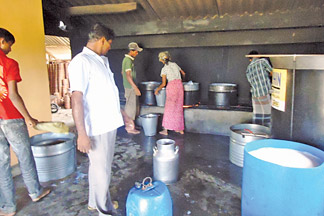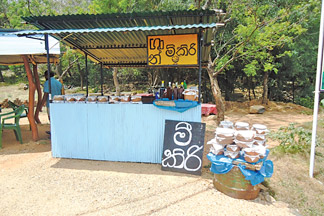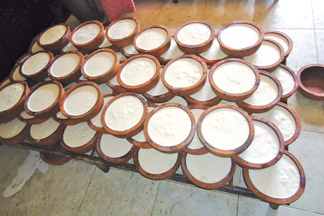Good times for Kantale curd industry
By Mohammed NAALIR reporting from Kantale
|

Extracting fat from milk
|
The Government has implemented major development projects in the
North and the East to improve living standards of the people and to
uplift the regional economy under the Uthuru Wasanthaya and Negenahira
Navodhaya development projects.
Once the development projects are completed, the North and the East
will remain as the centre of the development process. New business
enterprises and industries have come up in the region. Existing
industries are being further developed.
The attention of domestic and foreign investors have turned towards
the North and the East. They are ready to invest in various industries.
A new Industrial Estate has been set up close to Monkey bridge on the
Habarana-Trincomalee main road beyond Thambalagamuwa. Tri Star apparel
manufacturers is also running a garment factory. It has given employment
to rehabilitated LTTE female cadres. Several garment and industrial
parks are to come up in the North and the East.
This country is gifted with natural resources and certain areas are
famous for various products. For instance Wennappuwa area is famous for
clay related products, Kajugama for cashew nut. Likewise Kantale is
famous for milk products.
The curd industry is also one of the main livelihoods of the people
in this area. A large number of dairy farmers are engaged in curd
production on a massive scale. There are more than 200 curd stalls on
the Habarana-Trincomalee main road between Agbopura and Kantale.
|

A curd stall |
Kantale curd is also available in Kandy, Matale, Kurunegala, Dambulla
and Ambalangoda markets. Since the elimination of terrorism, a large
number of small dairy farmers has embraced the curd industry in Kantale.
Over 1,000 litres of curd is dispatched to various parts of the
country from Kantale.
N.D.P. Premasiri who is running a mega scale curd processing centre
under the logo Isuru Meekiri close to Agbopura town said that he
supplies more than 400 litres of curd to the market daily. He also plans
to set up a yoghurt plant.
Now the curd industry could see a resurgence parallel to paddy
cultivation, he said.
|

Curd pots |
After the development of the Habarana-Trincomalee highway the arrival
of tourists specially domestic tourists has increased considerably. This
has encouraged the curd industry.
Tourists are also purchasing more than 200 litres of curd from this
area daily. The development of roads is essential progress.
With the development of the A-6 road on the Habarana-Trincomalee
highway, a large number of boutiques, tea shops and road side sellers
has come up along both sides of the road from Hatharaskotuwa to Kantale.
Women and men can be seen along the road with bundles of firewood,
fruits like cashew, would apple, lime and slim apple (Beli).
Premasiri said that he also supplies enough milk to Highland/Milco
companies.
Premasiri told the Sunday Observer that nine people are working in
his curd factory and he plans to give employment to nearly 20 persons
after developing his factory.
He is also running a dairy farm parallel to the curd industry.
Premasiri has won the first prize in 2010 for good cattle breeding in
the Eastern province.
The Central Bank implemented assistance programs to uplift the dairy
industry in the Eastern province.
He said that lack of pasture land hampers his industry. He has
requested a plot of land to develop the industry. Pasture land is
crucial to promote the industry. The present facilities are
insufficient, he says. Premasiri said that he could supply curd to
Kandy, Warakapola, Colombo and Ambalangoda markets, because of the
increase in production. Curd producers are seeking Government help to
provide basic facilities to develop this industry. Under the first phase
of the proposed development program, Premasiri plans to plant grass in a
five-acre land area to feed milch cows and buffalos.
Premasiri Karunaratne another main curd producer in the area said
that he is engaged in this industry for more than 30 years. He does not
have his own dairy farm. He purchases milk from other dairy farmers. As
the price of milk has gone up running this industry has become difficult
for him.
The price of clay pots used to store curd has also gone up. A curd
farmers' income is only sufficient for his daily need. After the recent
floods dairy production of the area has declined by almost 50 percent.
Earlier he purchased more than 500 litres of milk daily for curd
production. "We used to sell a huge quantity of milk to the Milk Board
and used a portion for curd production", he said.
"We supply curd to Ambalangoda, Hikkaduwa, Gampaha and most parts of
the country. A bottle of milk is purchased at Rs. 40. One and a half
litres of milk is needed to make a pot of curd".
During rainy days, curd production drops. He said that there are 10
to 15 persons who are engaged in large scale curd production. With the
increase of the number of curd producers production has increased to a
very great extent", he said. |

